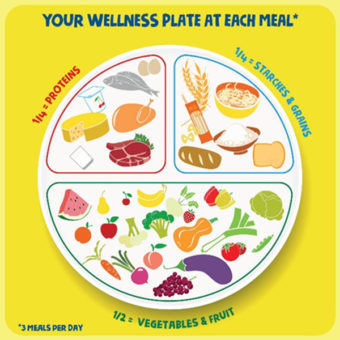
No more excuses when it comes to making healthier food choices. Whether you are eating out or cooking at home, try these substitutes with common meals to increase the nutritional value of your dish and reduce the added salt content.
1. Pizza
More: Vegetables (peppers, spinach, dried tomatoes, avocado), fruits (pineapple, pear, apple), unsalted nuts, chicken.
Less: Pepperoni, bacon, ham, extra cheese.
2. Noodles or pasta
More: Tomato-based sauces, in-season vegetables (steamed or lightly sautéed), chicken.
Less: Cheese, bacon, sausage.
3. Burgers
More: Fresh vegetables (lettuce, tomatoes, cucumber), avocado, jalapeños, sautéed onion and mushrooms.
Less: Bacon, cheese, BBQ sauce.
4. Sandwiches
More: Fresh vegetables (lettuce, tomatoes, cucumber), fresh herbs (basil), roasted peppers, avocado, sautéed onion and mushrooms, chicken, egg, mozzarella cheese, reduced-fat mayo.
Less: Ham, Cheddar cheese, pickles, mustard.
5. Salads
More: Fresh greens, vegetables and fruits, dried fruits (raisins and cherries), raw or unsalted nuts, dressings on the side.
Less: Salty nuts or seeds, dressings on the salad.
6. Salt – Sodium can raise your blood pressure, but certain foods can help lower it. So, instead of adding salt to your meals, try these matches:
• Beef: bay leaf, nutmeg, onion, pepper, sage, thyme.
• Pork: garlic, onion, sage, pepper, oregano.
• Chicken: ginger, oregano, paprika, rosemary, sage, thyme.
• Fish: curry powder, dry mustard, lemon juice, paprika, pepper
• Carrots: cinnamon, cloves, marjoram, nutmeg, rosemary, sage.
• Tomatoes: basil, bay leaf, onion, oregano, parsley, pepper.
• Potatoes: garlic, onion, paprika, parsley, sage.
• Greens: onion, pepper, lemon juice.
“There is often confusion around smart eating. Whether it’s how much is enough, that elusive appropriate serving size debate or being unsure of which ingredients to include,” says Nestlé nutritionist Madidimalo Tshikovhi. So, here is a guide on how your plate should look:





